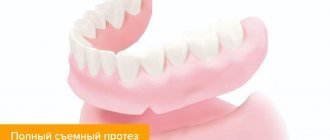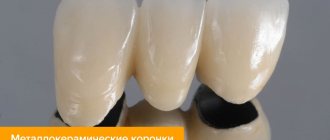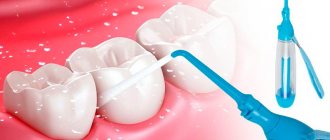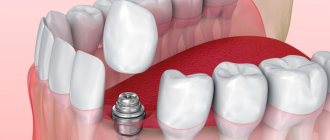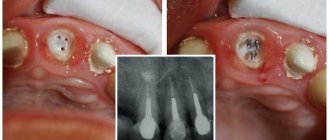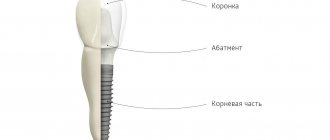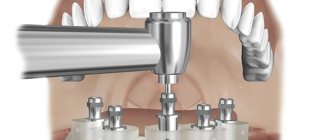Dental implants or bridges are used to restore lost teeth. Both options are functional and aesthetic. However, there are significant differences between them. To fix the bridge, the units adjacent to the defect are depulped and ground down. Due to improper load distribution, they gradually collapse and the jawbone atrophies. For an implant, these problems are eliminated. It is implanted into the jaw without the use of healthy teeth and prevents bone loss. When choosing a method, the patient should focus not only on finances, but also on long-term results.
In the photo - a dental bridge (left) and an implant (right)
What are bridges and dental implants?
A bridge is a permanent dental prosthesis consisting of crowns welded together, the outermost of which are fixed on previously ground living teeth. Used to restore 1-4 missing units in a row. The number of support units is always two. Bridges are usually created from the following materials: metal ceramics, zirconium dioxide. We install only metal-free structures.
Dental implants are artificial analogs of tooth roots that act as supports for individual crowns or dentures. Manufactured from medical titanium, biocompatible with oral tissues. Indicated for single, partial and complete edentia. They are implanted into the jaw using the following methods: classic, express, simultaneously with tooth extraction. They fully restore the functions and aesthetics of the dentition.
Dental bridge: what material is best to choose from?
If we are talking about prosthetics of the front teeth, then according to statistics, most patients are dissatisfied with the bridges made for them.
As we said above, it is very difficult to make artificial crowns similar in color and transparency to neighboring teeth and, of course, good aesthetics today can be achieved mainly only by using metal-free ceramics - 1) Emax glass ceramics, 2) zirconium dioxide. But we also don’t forget about metal-ceramics, although there is one problem with it when prosthetizing the front teeth. Modern metal-ceramics in some cases can look almost as aesthetically pleasing as metal-free ceramics, but for this it is necessary - 1) to use expensive ceramic masses, 2) metal-ceramics must be made with the so-called “shoulder mass”. But this raises the cost of a metal-ceramic bridge to 20,000 rubles (for 1 Unit/crown). And this is practically the cost of 1 unit of pressed ceramics “Emax”.
Below we will talk in detail about which bridge is optimal for the front teeth (in terms of materials and budget). But with prosthetics with bridges in the area of chewing teeth, the situation is much easier, because here functionality is more important than aesthetics. And in this case, we have a number of optimal solutions, including more affordable ones, although the gold standard for chewing teeth is now expensive bridges made of monolithic zirconium dioxide.
Below we compare the following types of bridges -
- bridges made of metal-free ceramics (zirconium dioxide, E.max),
- metal-ceramic dental bridges,
- solid bridge made of cobalt-chrome alloy,
- adhesive bridge prosthesis.
Pros of the methods
If we compare both options, then both the bridge and the implant are non-removable structures, matched to the color and shape of the patient’s natural teeth, and restore the functionality of the dentition. However, each method has individual advantages.
Pros of bridges on your teeth:
- shortened treatment periods;
- minimum contraindications;
- affordable price.
Advantages of implants:
- functional, aesthetic;
- allow you to restore any number of lost units;
- suitable for restoring terminal defects of the dentition;
- prosthetics with single crowns, bridges and complete dentures;
- have increased stability;
- distribute the load evenly, protect the jaw bone from resorption;
- crown replacement is performed without removing the titanium root;
- have a lifetime service life (for Nobel Biocare models).
The main advantage of implants compared to classic bridges is that to install the prosthesis, it is not necessary to grind down the units adjacent to the defect.
Crown and dental implant
In orthopedic dentistry, a crown is a product that replaces the visible part of a natural tooth. This design can be single (in the case of restoration of one tooth) or be an element of a bridge or even a removable laminar prosthesis. The same applies to implants: the titanium pin itself replaces only the root part, and the prosthesis installed on it replaces the coronal part. That is why the radical formulation (dental implant or crown) does not make sense initially, since the implant is only an element of an orthopedic structure, which also includes a crown with an abutment.
Contraindications
Among the limitations to classical bridge prosthetics:
- diseases of periodontal tissues (periodontal disease, periodontitis);
- serious malocclusion;
- pathological abrasion of enamel;
- inflammation of the oral cavity;
- osteoporosis and other diseases of the jaw bone tissue.
Dental implants are contraindicated in the following cases:
- high blood pressure;
- blood diseases;
- malignant neoplasms;
- diseases of the cardiovascular, endocrine, nervous systems;
- uncompensated diabetes mellitus;
- mental disorders;
- HIV AIDS;
- tuberculosis;
- infectious processes in the body;
- gum disease;
- age up to 16 years.
Implantation is also not performed in case of relative contraindications - lactation and pregnancy in women, if the patient has bad habits (smoking, alcohol abuse, drug use).
Possible complications
After installing the bridge, the patient may encounter the following problems:
- sensation of a foreign body in the mouth in the first 5-7 days;
- pain (if you have this symptom, we recommend that you consult a doctor);
- food getting under the prosthesis (in case of improper fixation of the structure);
- peeling off crowns (occurs with bruxism in a patient);
- exposure of the neck of the supporting unit.
Complications after implantation occur in less than 5% of clinical cases. Among them:
- bleeding (occurs when a patient has a blood clotting disorder);
- pain (in the first 5-7 days this is a normal reaction to surgery, after this period it is a reason to consult a doctor);
- seam divergence;
- perforation of the bottom of the maxillary sinus;
- damage to the mandibular nerve (accompanied by numbness);
- peri-implantitis (inflammation of the gum tissue around the implant);
- design rejection.
Comparison of methods by characteristics
Prosthetics on implants and a bridge have a number of fundamental differences. Each technique has advantages and disadvantages. The doctor chooses the technology after assessing all factors.
Advantages
Implants are able to withstand increased chewing loads, distributing them evenly across the jaw, due to this they are not destroyed during operation. Unlike classic bridges on your teeth, which require systematic re-cementing, implants are implanted once and for life.
In the case of classic bridges, the load falls on the supporting teeth. This can lead to their gradual destruction and removal. The size of the prosthesis will increase until there are no units left to act as support. At the site of the defect, bone tissue atrophy will continue. Implantation solves this problem.
Flaws
The main disadvantages of implantation include:
- high cost - but considering that implants are installed for life, the costs are justified;
- many contraindications - currently the list of contraindications has decreased, new technologies have been developed;
- treatment period (if a two-stage protocol with delayed loading is used, accompanied by osteoplastic intervention) - one-stage technologies will allow you to restore the dentition in 1-3 days.
Installation of a bridge requires the preparation of two supports. It’s sad if you have to injure healthy units. Due to the uneven redistribution of mechanical load, bone tissue atrophy accelerates, the contour of the gum changes and sags. A gap appears between the bridge and the gum where bacterial plaque and food particles accumulate. Not all prosthetic structures are subject to repair and relocation. Teeth under crowns are subject to secondary caries, which will lead to rapid tissue destruction and an increase in the length of the defect.
Contraindications
Implantation is a surgical procedure with some contraindications. But unlike the classic bridge, a number of protocols can be used for serious periodontal pathologies, problems with bite, occlusion, and a complicated medical history.
Both methods are contraindicated in:
- inflammatory process of the oral cavity;
- infections in the acute stage;
- chronic diseases in the stage of decompensation.
Absolute contraindications to implantation include oncology and severe bleeding disorders. A bridge is not installed in cases of terminal and long-term defects (loss of 4 units in a row or more), malocclusion pathologies, or low height of dental crowns.
Possible complications
The survival rate of implant structures is 98-99.9%. But in rare cases, complications are possible - peri-implantitis (inflammation of the tissue around the implant), rejection of the artificial root. Engraftment of the implant structure requires the professionalism of the doctor and the patient’s compliance with the instructions in the postoperative period and beyond.
After installing a bridge structure, the neck of the supporting teeth may be exposed due to subsidence of the gums. With bruxism, restorations may fall out of the prosthesis. Due to improper redistribution of mechanical load, the bridge wears out faster, the supports under it become loose and shift.
Life time
The manufacturer indicates the service life of the implant is 20 years or more. With proper care and regular dental care, an artificial root will last a lifetime . An orthopedic structure installed on implants requires replacement no earlier than after 10-25 years (structures made of zirconium dioxide - 20 years and above).
The service life of a dental bridge, due to rapid wear due to bone subsidence, averages 6-10 years (depending on the material).
Price
When considering the question of what is cheaper, a bridge or an implant, we focus on the long term.
- Installing a metal-ceramic bridge of three artificial crowns costs 20-25 thousand rubles. per unit , zirconium - 40-60 thousand rubles per unit . Preparation is paid separately - depulpation of 2 support units costs 10-18 thousand rubles.
- Installation of a classic ROOTT implant on a turnkey basis costs 28 thousand rubles. , plus a metal-ceramic crown 28 thousand rubles. (zirconium - 35 thousand).
The final price of prosthetics is not too different. Considering that the bridge will have to be re-cemented every 6-10 years, which may require treatment and restoration of supporting units, implantation will allow for a more cost-effective restoration of the dentition.
Implants are a profitable solution
Classic bridge prosthetics is less expensive than implantation. However, if you take into account the costs of depulping the supporting units before installing a bridge and the need to replace the prosthesis every 7 years (in the best case scenario), implants are a profitable solution. Titanium roots do not destroy healthy teeth and have a lifetime service life, and zirconium dioxide crowns will not require replacement for at least 20 years.
Levin Dmitry Valerievich
Chief physician, Ph.D.
Dental bridge or implant - which is better from an economic point of view?
The question of what to install (a bridge or an implant) in the event of the loss of one or more teeth is also relevant from a financial point of view. If you are on a limited budget and cannot afford to restore your teeth with implants, choose bridge structures. But keep in mind that classic bridges have a limited service life and need to be replaced over time. In the long term, implantation is a more profitable option for restoring teeth, despite the fact that implant-supported dentures are the most expensive. For example, one budget category implant and metal-ceramic crown will cost approximately 35,000 rubles: premium implants and prostheses can double this amount.
Classic bridges are cheaper: the price for a bridge of three crowns starts from 30,000 rubles. Designs made of ceramics and zirconium dioxide will cost more. For example, a ceramic bridge made using E-max technology costs from 60,000 rubles. Agree, this amount does not fit into the budget solution. In addition, the price of installing a classic bridge does not include the cost of preparing supporting teeth, while depulpation of one molar can cost more than 5,000 rubles. Add to this amount further expenses for replacing the prosthesis. As a result, the cost of a conventional bridge will be comparable to the cost of implantation.
What is better to put on the front teeth?
Implantation is the best option when restoring anterior units. This is due to increased demands on aesthetics. The bridge initially corresponds to them, but gradually, due to atrophy of the jaw bone, it sags, becomes mobile, and a gap appears between it and the gum. The implant, on the contrary, preserves the healthy appearance of the gums and compacts the surrounding bone tissue. As part of the classical installation method, the formation of the correct gingival contour is additionally carried out. Aesthetics do not deteriorate throughout the entire service life of the structure.
What to choose for a chewing tooth
In this case, the bridge and the implant have their own advantages and disadvantages. A bridge allows you to quickly restore the functionality of the dentition and cope with the chewing load normally. However, uneven distribution of pressure gradually leads to destruction and removal of supporting teeth.
The implant does not have a destructive effect on neighboring units; in all respects it is identical to a natural tooth. However, when installing a titanium root in the masticatory region, loading with a full-fledged prosthesis is not allowed until the artificial root has completely engrafted.
Indications for installing a bridge on abutment teeth
In some cases, it makes sense to think about installing a bridge structure. For example, you may choose this method if the adjacent teeth are damaged by caries or chipped due to injury. In this case, it is advisable to treat them and cover them with crowns. Bridge prosthetics is also used when the patient lacks financial resources, due to which he cannot yet undergo implantation. Contraindications can also become an obstacle to the installation of artificial roots, many of which, however, are temporary.
Clinical cases
- If one tooth is missing . When restoring a single defect, the condition of neighboring units is taken into account. If they are healthy, it is better to choose implantation, since bridge prosthetics involves depulping the supporting teeth. If they are already pulpless, you can install a bridge.
- If several teeth are missing in a row . The choice of method depends on the extent of the defect. A bridge can restore no more than four missing teeth in a row. Implants - any quantity. In this case, it is not necessary to place a separate rod in place of each lost unit. There are options to fix a smaller number of titanium supports and cover them with a bridge. A bridge on implants does not destroy healthy teeth, the load is distributed evenly, and jawbone loss is eliminated. Plus treatment is cheaper.
- End defect . If the outermost teeth in a row are lost, the only option is implantation, since to fix the bridge at the edges of the defect there must be two supports.
What teeth to put in if the jaw is completely “empty”?
Unfortunately, it also happens that a person is left completely without teeth on one of the jaws, and sometimes on both at once. What should he do in this case? Of course, you can just come to the dental clinic and ask: “I want to insert teeth - which ones are better? Tell". But it is advisable to understand at least a little about the issue of prosthetics in order to make the best choice. What does dentistry offer for complete edentia? Here are the main ways to restore teeth in this case:
- Complete removable dentures.
Very easy to install structures, which are artificial gums (base) made of acrylic or nylon with crowns fixed on it.When a patient decides to install complete removable dentures, which is better to choose - acrylic or nylon? There is no clear answer here; you need to look at the specific clinical situation and the wishes of the patient himself. In some cases, nylon is preferable, since it looks much better, is more comfortable to wear and can be installed by people in extreme professions (acrylic will not suit them, because due to its rigidity it can cause injury in the process of a fall or other unforeseen event). But sometimes it’s better to go with acrylic, which is stronger and better withstands chewing loads. When choosing removable dentures for teeth (which is better), you should ask your dentist - he will give individual recommendations.
- Prosthetics on implants.
There are several options for such dental restoration: bridge structures on implants (in case of complete edentia, they are installed in “sections”: several dentures on one jaw), removable dentures on implants (this method is especially recommended for the lower jaw, on which the usual removable structure does not hold very securely) and even clasp ones. Implantation serves as a support for the main prosthesis and makes it more reliable. If the patient is not afraid of serious stress on the body and is ready to invest a lot of money in restoring the health of his oral cavity, he can carry out a complete implantation of the entire dentition; modern technologies allow this possibility. - All-on-4.
A modern and very reliable method of restoring teeth, which is much more economical than full implantation. The essence of the method is that four implants are implanted into the jaw, on which the main structure is then installed, restoring the entire dentition.
Dental surgeon, implantologist at the 32 Dent clinic Sergey Leonidovich Yakubovsky: “We recommend All-on-4 prosthetics to patients with complete edentia as a gentle and very reliable way to regain their teeth. Full implantation is quite a serious burden on both the body and the patient’s wallet. And here there is an opportunity to restore the dentition at an affordable price, for a long time and with good aesthetics.”
Which teeth are better to insert: prices for prosthetics
Complete removable structures will cost 15-55 thousand rubles. If you plan to install them on implants, the cost of implantation will be added here, so the price will be higher - from 58 to 80 thousand rubles. All-on-4 prosthetics will cost approximately 50-60 thousand rubles (depending on the chosen main prosthetic design and types of implants).
Which dentures are best to install?
? It is advisable to at least have a rough idea of what you want when going to the dentist. And the doctor will help you navigate and choose the optimal method for a particular case, tell you about all the pros and cons of the chosen method and carry out proper installation. The main thing is to choose a good doctor!
What is better - dental implantation or bridge?
For a clear example of the strengths and weaknesses of both options, we provide a comparative table.
| Bridge | Implant | |
| Number of missing teeth | 1-4 | any quantity |
| Degree of mastication recovery | average | full identity to a natural tooth root |
| Aesthetics | average | high |
| Recovery time | up to 1 month | 4-6 months, with bone grafting - up to 1 year |
| Difficulty of installation | average | complex |
| Impact on adjacent teeth | subject to depulping and turning | are not used |
| Jaw bone loss | intense | absent |
| Reliability of fixation | mobility of supports is possible in case of diseases and inflammation of periodontal tissues | complete immobility |
| Difficulty of care | Difficulties arise when food gets under the prosthesis | does not require special care |
| Restrictions on food intake | increased load excluded | any load is allowed |
| Comfort while wearing | There is discomfort in the first days after installation | complete comfort |
| Life time | up to 7 years, depending on the condition of the support units | implant - for life, prosthesis - 15 years or more |
| Price | Average | High |
Our dentists recommend that patients do not delay the restoration of missing teeth. Without load, the jawbone begins to atrophy. The method of filling a gap in the dentition must be decided quickly. Each patient, taking into account his financial capabilities, makes his own decision - whether it will be a bridge or an implant.
Top 10 reasons why you should choose an implant over a dental bridge
1. Installation of implants is painless
The installation of a dental implant is painless, since local anesthesia is used, and the procedure takes an average of 20 minutes, which allows for minimal tissue trauma, shortening the rehabilitation period and the tissue healing process in the next few days.
2. Minimal surgical intervention
The installation of a dental implant involves a minimal amount of tissue, so the patient does not need to spend a long time in the dentist’s chair. The procedure itself for implanting one dental unit can take, depending on the complexity, from 15 minutes (when restoring the front teeth) to 40 minutes (when an artificial root is implanted in place of the lost outer chewing teeth). In modern dentistry, several implantation options are presented, including one-step and one-stage procedures. They allow you to avoid repeated surgical procedures for prosthetics and gum formation.
3. Minimal risk Installation of a high-quality dental implant is successful in 98-99% of cases. Much of the success is undoubtedly related to the qualifications of the doctor, as well as the quality of the materials used and the brand of the implant. However, it is important for the patient to remember that the service life of the artificial root directly depends on careful care and respect for one’s health. In the long term, the implant can last more than 20 years. For comparison, it can be noted that when restoring teeth with a fixed bridge supported by one’s own teeth, the risk of loosening and infection is greater, and their service life is limited to 4-8 years.
4. The implant preserves healthy teeth
Installing a dental implant allows you to save adjacent teeth from grinding, preparation, nerve removal and root extraction. After a long period of using implants, neighboring teeth do not experience overload, as when wearing a dental bridge, so they are protected from loosening, injury and loss.
5. Preservation of bone tissue After a tooth is removed, in the area of the gap formed, the bone tissue is no longer supplied with nutrients and becomes smaller in volume. The gum level noticeably sags up to 1 mm per year, which ultimately can cause weakening of the ligamentous apparatus of other teeth. The implant puts a natural load on the bone tissue area, stimulates further functioning and prevents the death of microcapillaries and blood vessels.
6. The implant imitates a natural tooth
A dental implant more naturally restores a lost tooth in terms of functionality, as it is anchored inside the bone, like your own tooth root. The crown is also closer in appearance and can also withstand greater loads than removable dentures.
7. Reliable and Safe Solution With dental implants, chewing forces are better supported and balanced across the entire dentition, reducing stress on individual units and the jaw joint.
Successful installation is possible by choosing a higher quality implant or a proven, reliable brand. Top manufacturers include implants Alpha-bio, Nobel Biocar, Straumann and others. However, the healing rate and duration of service may vary depending on your health status. Smoking, diabetes, gum inflammation, chronic blood and bone diseases greatly affect the results of the operation. They can reduce survival rates by up to 90%. This is because additional treatment must be performed before any attempt to place an implant.
8. More durable results Compared to other types of dentures, a dental implant has a longer service life - more than 20 years. Removable dentures, as a rule, are replaced after 3-5 years, clasp dentures can last about 6 years, dental bridges - up to 8. The reason for replacing the structure is most often bone resorption and changes in the contour of the gums.
To restore lost teeth, there is no need to replace each unit. If several teeth in a row are missing, then using a dental bridge supported by implants will effectively eliminate the defect. A dental bridge has high aesthetic values, a strong and durable frame. To prevent the development of atrophy, implants are selected to fill the gap with the most appropriate number of artificial supports. To restore chewing teeth, more massive implants with a larger diameter are required. The distance between them must be at least 3 mm. This way you can reduce the number of units used without losing quality. If a complete restoration of the jaw is planned using a bridge that includes 12-14 teeth, then 4-6 implants are used to fix it. The prosthetic technology (All-on 4 and All-on 6) has been clinically proven to be effective and preserves the gingival contour for more than 5 years of use, and the service life of the prosthesis is more than 10-20 years.
9. High level of comfort A dental implant is a solution that provides functional and aesthetic comfort. The places where the crown is attached are invisible and hidden by the gum. You need to care for an implant like you would your own tooth, while removable dentures are more demanding to care for and their use is noticeable to others.
10. High biocompatibility Modern implants are made from safe and biocompatible materials. The main metal for creating artificial roots is titanium, a durable, refractory and bioinert material. Impurities are used in minimal quantities, which reduces the risk of developing allergies. Spraying of minerals, a hydrophilic surface, and various types of threads allow the use of implants in complex clinical situations. The success rate of implantation surgery is 98% because the titanium dental implant is organically compatible with the human body.
